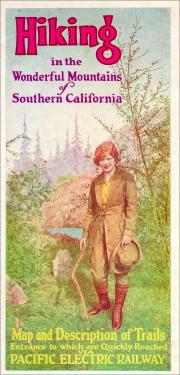 |
Trails and Camps Revisited
By Jake Brouwer
 |
This Fall of 1998 issue will be a small tribute to the
trails and camps in the area around Mt. Lowe. Our subscribers though all Mount Lowe fans have come to know our Scenic Mount Lowe from different vantage points and often once finding a place of such diversified beauty we settle in for the prolonged stay.I discovered Mt. Lowe while out prospecting and investigating the story of a gold mine tucked away in Millard Canyon. Others start on Mountain Bikes and whiz down trails suddenly coming on a great old
ghost town above the sprawling metropolis below. I know of many that followed the rails of the Pacific Electric Railway and upon reaching the city of Altadena they were suddenly lifted to the clouds on an incline railway. However we find Mt. Lowe, it is in our hearts to stay and explore. After finding Mt. Lowe I hope you will do as I did and take the time to discover the surrounding area, filled with beauty and historical significance.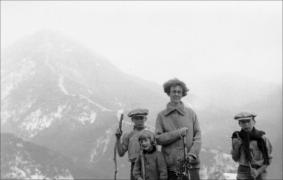 |
The Great Hiking Era continued on until
around 1938. In this snapshot relatives of subscriber Joyce DeZwart are shown on the
trail near Mt. Lowe in April of 1927. |
For those of you who have not yet explored the areas surrounding Mt. Lowe and Echo Mountain, I hope this issue will appeal to your sense of adventure and exploration. For those of you who have toured these trails perhaps the memories brought forth will bring a smile to your face. I would like to say at the bringing of this writing that by far the best and most informative book on the area is The San Gabriels by John W. Robinson and perhaps the second most useful book in exploring this wilderness playground is his book Trails of the Angeles.
In the late 1880’s our local mountains had added to its list of desirable qualities, recreation. It was around this time that the Great Hiking Era started and people from the lowlands of southern California headed into the wilds of the San Gabriel Mountains. In those days of no television folks actually left their homes and ventured into the hills for adventure. Cool mountain air and fabulous views brought hikers to the upper reaches of the San Gabriels, while bubbling streams, cascades, and sylvan settings lured them into the canyons. For some it was a sporty challenge and for others it was a peaceful and spiritual coexistence with nature.
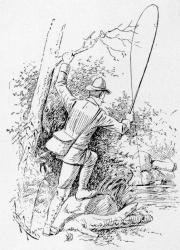 |
Indians used some of our early trails long before the white man came to California. Hunters, trappers, loggers and fishermen established other trails and still others were the old trails that were built by the early homesteaders and squatters. Wilson built trails as did Lowe and other enterprising businessmen for as the population headed to the hills small camps and trail resorts began to spring up to off food lodging and hospitality to the hikers. It was a very popular pastime.
One of the closest camps to the Scenic Mt. Lowe Railroad was Camp Mirriam, which was named by Judge J. H. Mirriam in 1904. The judge had discovered a spring on a ridge above Millard Canyon and after building a cabin there soon found himself surrounded by six other similar minded folks desiring such a beautiful surrounding and a spring to boot.
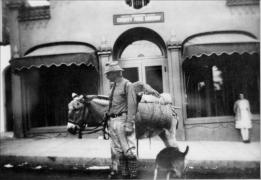 |
In 1930 a yound Angelyne (Smith) Kinstle stands in fron
of the Altadena Library looking at her friends C. W. Siefert and his burro Molly before
they headed back to Camp Sierra. Also in the picture is one of his renowned trained police
dogs. This picture was taken on the East side of Lake Avenue near Mariposa just above
Webster's Drugstore. |
The camp had great views of the valley and on a ridge above it circling the mountain could be seen the Mt. Lowe trolley. One of the visitors to the camp was C. W. Siefert who enjoyed the place so much he decided to stay. After a harrowing windstorm blew the judge’s cabin and others off the side of the mountain Siefert decided to stay on as the proprietor. Siefert rebuilt the cabins and renamed the spot Camp Sierra. Mr. Seifert made side money by collecting ferns and hauling them once a week into town on his burro named Molly. The ferns would be sold to local Altadena florists and the money used to buy supplies. On many of the trips back up Lake Avenue C. W. Siefert was joined by Angelyne (Smith) and Robert Kinstle. Siefert knew their grandfather Gregor Vetter and they were friends both hailing from Baden, Germany. Angelyne and Robert often visited Mr. Seifert on the way to visit Mt. Lowe.
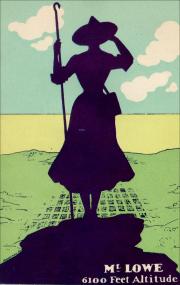 |
To visit the area that was Camp Sierra go to the locked fire gate near the end of Chaney Trail Drive and walk up the Sunset Ridge Fire Road, a bit more then half way up on your left is the old camp site. A nicer alternative is the Sunset Ridge Trail, which follows to the left of the fire road and offers a wonderful woodsy hike.
The accommodations at Alpine Tavern later renamed the Mt. Lowe Tavern, offered trails which went off in a variety of directions. In an early Pacific Electric brochure titled Hiking in the Wonderful Mountains of southern California 10 different hikes are listed. 1. Echo Mountain via Sunset Point Trail. 2. Echo Mountain via Castle Canyon Trail. 3. San Gabriel Peak via government Trail. 4. Rubio Canyon via Lone Tree Trail. 5. Arroyo Seco Trail. 6. West Fork to Opids Camp. 7. Mt. Wilson Trail. 8. Barley Flats via Barley Flats Trail. 9. Switzers Camp via Arroyo Seco Trail. 10. Switzers camp via Bear Canyon Trail.
Some of these trails are still in existence others have been wiped out by floods, erosion and overgrown form lack of use. Be sure to read a good up to date trail guide before heading off for one of these historic trails.
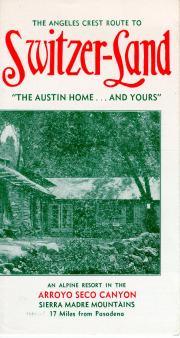 |
The camp was built by Commodore Perry Switzer in 1884. Switzer worked as a carpenter and contractor in Pasadena. Switzer heard the tale of a young married couple who spent a month in the Arroyo Seco Canyon. They told the story of incredible beauty complete with dashing streams, crystal pools, rugged gorges, and towering waterfalls. Above one of the falls was a flat were the couple spent some peaceful time together.
Switzer hued out a rough trail into the canyon and then packed in tents, kitchen equipment and food. Adds were soon placed in the local papers and publications and guests began to pour in. It was a fairly good concern until 1896 when a forest fire devastated the camp and the surrounding forest.
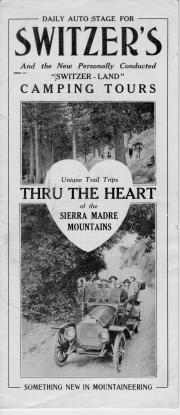 |
In 1905 Clarence Martin of Martins Camp near
Mt. Wilson rebuilt the Switzers and was instrumental in putting in a single wire telephone, a very early convenience for the mountainous area. It was in 1909 that Switzers was the base camp for the search party that went looking for the crew of the lost balloon the American.In 1911 Lloyd Austin came to the Arroyo Seco Canyon and became fascinated by the rugged and wild beauty of the canyon. Borrowing the money to buy the camp, he and his wife made the newly named Switzer-Land the number one resort in the mountains. It was Austin that built with donations the Christ’s Chapel on a rocky outcrop two hundred feet above the upper waterfalls. The Chapel and its amphitheater that sat two hundred people became a popular center for conferences, youth retreats, weddings and of course Sunday morning prayer.
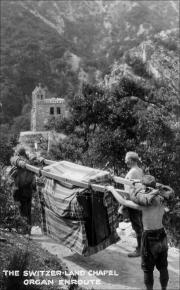 |
Switzer-Land offered unique trail trips into the heart of the Sierra Madre Mountains. Experienced trail guides accompanied all parties and all baggage was carried in by pack animals. For those eager for the joy of camp life all that was needed was a few toilet articles and strong shoes with heavy soles. Everything else was provided and taken care of by the gracious hosts of the camp.
At the Switzer-land Inlet one could buy groceries, cigars, confectionery, and postcards. They were also the issuers of camp fire permits.
The Austin’s made Switzer-land’s hospitality renowned through the southland. Aside from just enjoying the out of doors a tennis court was built and other things of interest to do were croquet, fishing, hiking, campfire entertainment, and the ever popular Switzer’s Saturday Night Dances in the boulder Lodge.
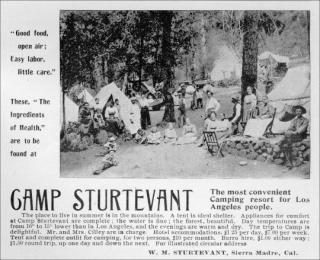 |
For those hearty hikers from Altadena it was only 8 1/2 miles away. From Pasadena it was 10 miles by auto stage and 3 1/2 miles by trail. Being on the doorstep of Pasadena and having the rugged San Gabriels as it’s back yard made Switzers a powerful location.
Today you can reach Switzer’s by taking the Angeles Crest Highway to just a half mile past the junction of the Angeles Crest and Angeles Forest Highways. Go down the road into the Switzer Picnic area and park. Follow the trail on the south side of the parking lot across a small footbridge. From here you enter into a lovely forest of live oak and bubbling streams. The occasional call from a crow or raven or perhaps the chirruping and coughing of a squirrel will be the only sounds you hear on an early morning hike.
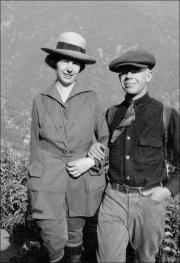 |
These are but a few of the trails and camps in the area surrounding our Mt. Lowe. There are too many more for this humble paper to hope to write about. Even to try and list them will surely result in missing a few.
The San Gabriels are full of such historic places and if but a name will get you looking I’ll toss out a few and hope you’ll take it from there. Camp Rincon, Follows Camp, Camp Bonita, Roberts Camp, Opids, Camp Sturtevant, and Oak Wilde. Please enjoy the trails and camps of our forests.
Send email to Echowebmaster@aaaim.com to report any problems.
Last modified: February 12, 1999
No part of this paper may be
reproduced in any form without written permission from:
Jake Brouwer
All articles and photos were provided by:
Land-Sea Discovery Group
Copyright © 1999